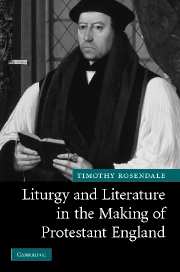INTERLUDE: 1549–1662
Published online by Cambridge University Press: 22 September 2009
Summary
The precautions and coercions with which the first Book of Common Prayer was hedged turned out to be well advised. Cranmer, in constructing a broadly acceptable (and probably intentionally ambiguous) order out of old and new materials, had anticipated in his essay “Of Ceremonies” that people toward both ends of the religious spectrum would still be displeased with the new book. This is exactly what occurred: while many people were generally content to follow the lead of Church and State, conservatives resented the replacement of an order they considered holy, and which had prevailed in England for nearly a thousand years; radicals lamented the many similarities of the new services to the old; and both were frustrated by the Prayerbook's formal and doctrinal ambiguities. The new books sold briskly in London, and Dryander wrote that “the English churches received the book with the greatest satisfaction,” but seething beneath the surface was a darker discontent that qualified Somerset's assertion of “as great a quiet as ever was in England.” The radical Zwinglian John Hooper, Somerset's chaplain and later bishop of Gloucester, wrote to Bullinger that
it is no small hindrance to our exertions, that the form which our senate or parliament … has prescribed for the whole realm, is so very defective and of doubtful construction, and in some respects indeed manifestly impious … I am so much offended with that book, and that not without abundant reason, that if it be not corrected, I neither can nor will communicate with the church in the administration of the supper.
- Type
- Chapter
- Information
- Liturgy and Literature in the Making of Protestant England , pp. 117 - 132Publisher: Cambridge University PressPrint publication year: 2007

